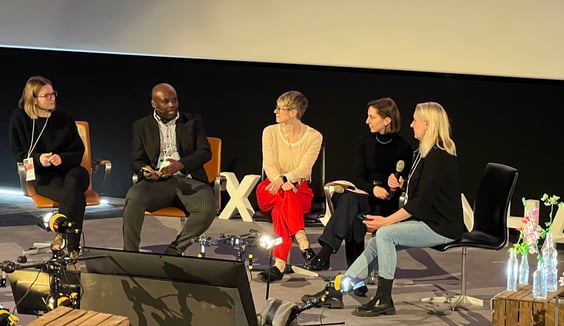UX and Design
Extended Reality in the new working world
17 January 2021 • 4 min read
-1.png?width=1920&height=836&name=Extended%20Reality%20In%20The%20New%20Working%20World%20(1)-1.png)
The chances are that, when most people think about extended reality (XR) - the umbrella term for virtual (VR), augmented (AR) and mixed reality (MR) technologies - they imagine someone wearing a headset and running around their living room as part of an immersive game.
However, the reality is that, as society has become more familiar with XR, these technologies that were once restricted to the gaming industry, or deemed too ‘futuristic’ to be used in the real world, are now readily accessible. They offer new opportunities to engage and convert customers, and offer enhanced ways for companies to improve how they operate and drive efficiencies across their organisations.
In a world that’s been turned on its head by the coronavirus pandemic - in turn forcing companies to confront new realities about how we work, shop and engage each other at a distance - what once might have seemed far-fetched now seems like an increasingly viable idea.
So if XR has moved beyond gaming, how are individuals and organisations using XR right now to improve - and create new - interactions with their customers and users?
The possibilities of augmented reality
Thanks to constant advances in mobile technology, as customers - for the most part - we’re already equipped to interact with one particular flavour of XR: augmented reality. An example of how we’re using XR in our day-to-day lives is the filters we use on social media platforms to turn ourselves into everything from animals to renaissance paintings.
AR particularly broke new records in 2019, with the user base of AR-supported mobile devices reaching 1.5 billion globally. And investment in XR only looks set to grow, with enterprise solutions now outpacing gaming and entertainment. In fact, 65% of recently surveyed AR companies are prioritising industrial applications over consumer ones.
Once the realm of ‘emerging tech’, XR technologies already offer ambitious organisations immersive new ways to operate and interact. If you complete a quick Google search, the results page will list endless ways XR is being used, including:
- The Russian billionaire who is creating an online world for music festivals and concerts.
- The two sisters in North Carolina using VR to fully understand the world through the eyes of someone with dementia.
- The scientists at NASA who are using VR technology to control robots on Mars.
Building virtual worlds
In 2019, VR vendors saw the biggest growth in enterprise adoption, at 46%, versus consumer adoption at just 24%.
Unlike AR or MR, VR immerses users in an entirely ‘other’ space. The healthcare sector is already using this technology and applying VR to improve patient care and create environments that stimulate physiological reactions to aid diagnosis. It’s also being used across sectors as diverse as manufacturing and defence to train employees and to manage risk and improve health and safety.
As the UK settles into the third iteration of lockdown, the viability of returning to the office feels like a distant reality, and it’s easy to see the adoption of VR - as well as MR and AR - becoming increasingly relevant. The novelty of spending time together as teams and organisations over Zoom has worn off, and many are wanting a more “human” connection.
Whilst XR doesn’t bring people back together physically, it can be used to drastically improve collaboration and communication within the workplace.
Outside of team meetings and socials, key focus areas where XR can be used include onboarding and learning and development. In fact, in a recent survey conducted by Perkins Coie LLP, Boost VC, and the XR Association, 70% of survey respondents believed businesses would introduce XR into employee training and development in 2021.
Using immersive technologies, organisations can effectively create “in-person” training for their employees, regardless of location. As well as making the sessions feel more human, this new approach to onboarding also has other benefits, including savings on travel and accommodation costs for participants and reduced travel risks.
Industries like manufacturing and healthcare can use simulated training scenarios to enable their people to “learn by doing”. Again this also has financial benefits for the organisations, as they are able to save on the cost of training materials and equipment.
And organisations like GIGXR are already working with healthcare, higher education and medical schools to introduce this new approach to training on a global level. By giving access to collaborative, true-to-life 3D simulations, as well as 2D screens and books, they are allowing the organisations they work with to broaden and deepen the impact of their vital training, whilst operating fully remotely.
Setting up your first experience team
The increasing adoption of XR is another example of the way our experiences with technology are happening across a broadening ecosystem, blurring the lines between digital and physical worlds across interactions, devices and channels. Smartphones are a prime example: simultaneously, they manage to be a shopping channel, a communication device and an augmented reality controller - and consumers rely heavily on them to manage and navigate their relationships, work and day-to-day life.
Designing and orchestrating these experiences - whether for your customers or your people - across this widening array of devices, platforms and touchpoints is no easy feat. It requires companies to look beyond single products and services and take an ‘ecosystem’ view that increasingly means meeting the end user on their terms, wherever they are.
At AND, we’re exploring the possibilities of XR with multiple clients to see how it can enhance both their customer experience and product offering. As well as developing several proof-of-concepts (POCs), we've also been working with a video production company to build a Unity-based 3D environment that will support the services they provide to their clients.
To learn more about the possibilities of extended reality for your organisation, or to discuss how AND can help you source the technical talent you need to deliver XR, get in touch.


